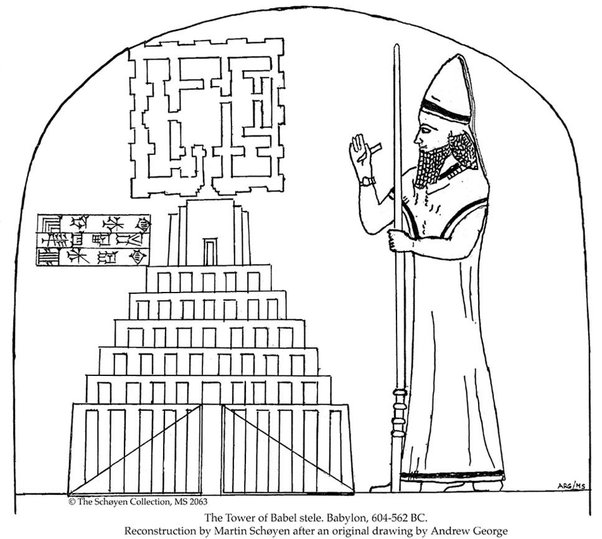“Now the whole world had one language and a common speech. As people moved eastward, they found a plain in Shinar and settled there. They said to each other, “Come, let’s make bricks and bake them thoroughly.” They used brick instead of stone, and tar for mortar. Then they said, “Come, let us build ourselves a city, with a tower that reaches to the heavens, so that we may make a name for ourselves; otherwise we will be scattered over the face of the whole earth.
But the Lord came down to see the city and the tower the people were building. The Lord said, “If as one people speaking the same language they have begun to do this, then nothing they plan to do will be impossible for them. Come, let us go down and confuse their language so they will not understand each other.”
So the Lord scattered them from there over all the earth, and they stopped building the city. That is why it was called Babel—because there the Lord confused the language of the whole world. From there the Lord scattered them over the face of the whole earth.”
When someone asked on Quora if there are any traces of the biblical Tower of Babel, I bet they didn’t expect the diverse answers they got, ranging from dismissive to mystical. In fact, several places have been suggested as possible sites for the biblical Tower of Babel, with Etemenanki being the most likely candidate in my mind.
Clair Jordan shared a slate found in Etemenanki that looks like a blueprint for the construction:

It is likely this was the biblical Tower of Babel because of the accompanying royal inscription of Nebuchadnezzar on the slab, which reads as follows:
The house, the foundation of heaven and earth, Ziggurat in Babylon. Nebuchadnezzar, King of Babylon am I. To complete E-Temen-Nnki and E-Ur-Me-Imin-Anki, I mobilized all countries everywhere, each and every ruler who had been raised to prominence over all the people of the world who were loved by Marduk, from the Upper Sea to the Lower Sea, the distant nations, the teeming people of the world, kings of remote mountains and far-flung islands. The base I filled in to make a high terrace. I built their structures with bitumen and baked brick throughout. I completed it raising its top to the heaven, making it gleam bright as the sun.
This fits with the biblical description of people from different countries working together on a tower made of bricks. Amazingly enough, traces of such a Tower still exist to this day:

Heaven and Earth
But why was Etemenanki built the way it was? Barbara Warrum has an interesting theory. The towering ziggurat was reported to have 7 layers, one layer for each of the 7 known planets of ancient times (the sun and moon were counted as planets).
Etemenanki meant ‘heaven and earth’, and it was seen as a three-dimensional model of the heavens and the earth.
Without modern telescopes, ancient people could see the Moon, Mercury, Venus, Sun, Mars, Jupiter, and Saturn with the naked eye. People could see that the seven appeared to travel in a certain zone in the sky, what we call the ‘circle of the zodiac’.
People could also see that some planets were evidently closer than others. Some planets were far away, some were closer, and they appeared to stay in their respective ‘layers’. These were the ‘7 heavens’.
Divide and Discuss
There were different ways of dividing up the heavens. People needed to divide them up so that they could be studied and discussed.
If you divide the circle of the heavens by the movement of the sun through the traditional ancient year of 360 days, then you have a circle of 360 degrees, the basis for our modern system.
The Babylonians and Egyptians had multiple calendars, but one of the calendars they both used was based on a 360 day year with 5 days outside the calendar, between the old and new year. This made for a total of 365 days. The Mayans also used this approach.
The Egyptians said the 5 days outside the calendar were when the 5 great planetary gods were born, Set, Nephthys, Horus, Isis, and Osiris.
The Mayans and Aztecs counted the 5 days as unlucky, and children born during those days might be destined for sacrifice.
Our modern time-keeping system of 60 minutes and 60 seconds also is due to the ancient Sumerians and Babylonians.
They noted the circle of the heavens was neatly divided every 60 years into a great triangle in the sky, based on the movements of planets Saturn and Jupiter.
The Sumerians used base 60 for their math system. 60/60 was counted as 1.
The three constellations of the zodiac that formed three points of a Great Trigon, or triangle in the sky, that marked out an element, were called Gods of Triplicity, or Triple Gods.
If you use the movements and timing of planet Jupiter to divide the heavens, then over the course of 12 years you divide the heavens into 12 sections. These are the familiar ‘houses’ of the zodiac. If you use Jupiter as your chief timekeeper, using it as the measuring instrument and ruler for your astronomical math, then Jupiter is the ruler of the heavens (pun intended, as that is why a foot-long ruler is divided into 12 inches).
Marduk the Ruler
The Babylonians in their construction of the Etenmenanki placed 4 gleaming statues at the base, one on each of the 4 sides. The 4 sides represented the East, West, South, and North of the world, and also the four elements. At each side was the planetary god who ‘ruled’ over, or held up that corner of the world.
At the top of the towering Etenmenanki was a gleaming statue of Marduk, or planetary god Jupiter, showing he ruled the heavens.
However, the 7th layer of heaven was normally occupied by planet Saturn, which was the highest planet, farthest away, and the actual ‘god most high’. Planet Jupiter is actually the 6th layer. So why was a statue of Marduk on the topmost 7th layer of the structure, since this rather destroyed the symbolism of the 7 layers representing the 7 layers of heaven?
The answer is simple: local politics decreed that Marduk should be on top, as chief god. Even in ancient times, politics ruled!


I want to believe it is what is left of the Tower of Babel, so have decided to do just that. 🙂
Best ishes, Pete.
LikeLiked by 2 people
That’s very good reason for believing something, Pete.
LikeLiked by 1 person
In the lack of any evidence to the opposite, I’m doing the same 🙂
LikeLiked by 1 person
This is amazing. So there was probably an element of truth in the Babel story.
I remember reading, many centuries ago, that many cultures have a flood story, too. Even the Maya in South America.
LikeLiked by 2 people
Oh, absolutely. From ancient Greeks to the Babylonians, the flood story is there. Also, it confirms data about the Mediterranean Sea being formed out of a valley when the Atlantic Sea came crushing through Gibraltar.
LikeLiked by 2 people
When I read that, I just had to shake my head in amazement; I mean: seriously? “Hey, these guys are doing really well. That will never do. Here’s something that will make their lives really difficult, and cause all sorts of enmities. See how you like that, humans!” If that’s people’s idea of God, you can keep it! Cheers, Jon.
LikeLiked by 1 person
Whoops: I commented out the comment! 😉 I should have headed my comment with:
‘But the Lord came down to see the city and the tower the people were building. The Lord said, “If as one people speaking the same language they have begun to do this, then nothing they plan to do will be impossible for them. Come, let us go down and confuse their language so they will not understand each other.”’
Hopefully that gives my comment context! 😀
LikeLike
No worries, I got it 🙂
LikeLiked by 1 person
Yeah, Old Testament God is a bit… temperamental.
LikeLiked by 1 person
Sorry if it was a bit pithy, but I kinda shot from the lip there…….. 😉
LikeLiked by 1 person
No worries, I know what you mean 🙂
LikeLiked by 1 person
Great to know.
LikeLiked by 1 person
Thanks, I’m glad you enjoyed it 🙂
LikeLike
Reblogged this on s a gibson.
LikeLiked by 1 person